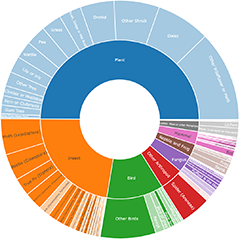Fruitbody thick walled, splitting from the top
At maturity, the fruitbody of a fungus in this sub-group is essentially a tough-walled ball (with or without some basal extension that forms a pseudo-stem) with powdery spores inside. In general, the ball splits from the top along a number of possibly irregular lines and the segments bend outwards to expose the mass of spores.
Most of the species in this group belong to the genus Scleroderma and these are known as earthballs. The fruitbodies, mustard-yellow in several commonly seen species, may measure up to about 7 centimetres across before splitting open and the segments (sometimes over 5 millimetres thick) have a leathery texture but often are at least slightly pliable.
Nothocastoreum fruitbodies are roughly spherical, 1 to 2 centimetres in breadth, greyish-orange and initially almost buried. The shell of the fruitbody is under a millimetre thick and, while fairly tough, it is brittle. Press hard enough and it will shatter. If nothing shatters it, the shell splits into numerous segments to expose the greyish spores. When empty of spores the bare whitish interior of the open fruitbody gives the impression of a multi-rayed star.
** Mycenastrum: Fruitbodies of the genus are roughly spherical, measure up to 20 centimetres across before splitting open and the segments have a tough, woody texture. It is not yet known from the local region but given the locations and habitats where it has been found, its occurrence in Canberra Nature Map area can’t be ruled out.
Announcements
There are currently no announcements.
Discussion
Unverified Fruitbody thick walled, splitting from the top
Scleroderma sp.
Scleroderma sp.
Scleroderma sp.
Top contributors
- trevorpreston 12
- AlisonMilton 10
- JackyF 9
- Aussiegall 8
- WendyEM 8
- Teresa 7
- LisaH 6
- AaronClausen 6
- Caric 6
- KylieWaldon 5
Top moderators
- Heino1 64
- Heinol 36
- KenT 22
- Teresa 9
- Heino 6
- CanberraFungiGroup 5
- Pam 5
- MichaelMulvaney 4
- Csteele4 4
- KerryVance 1


